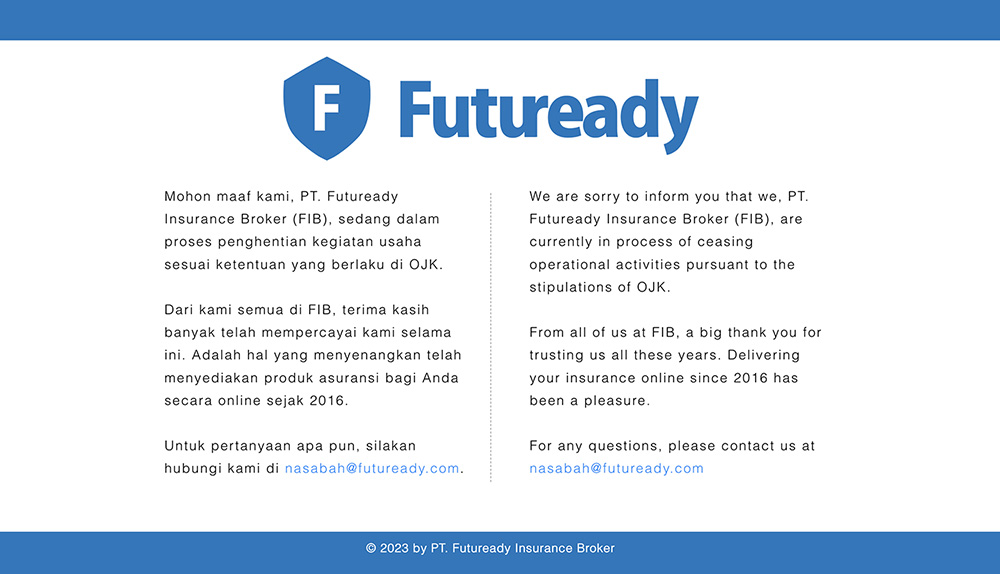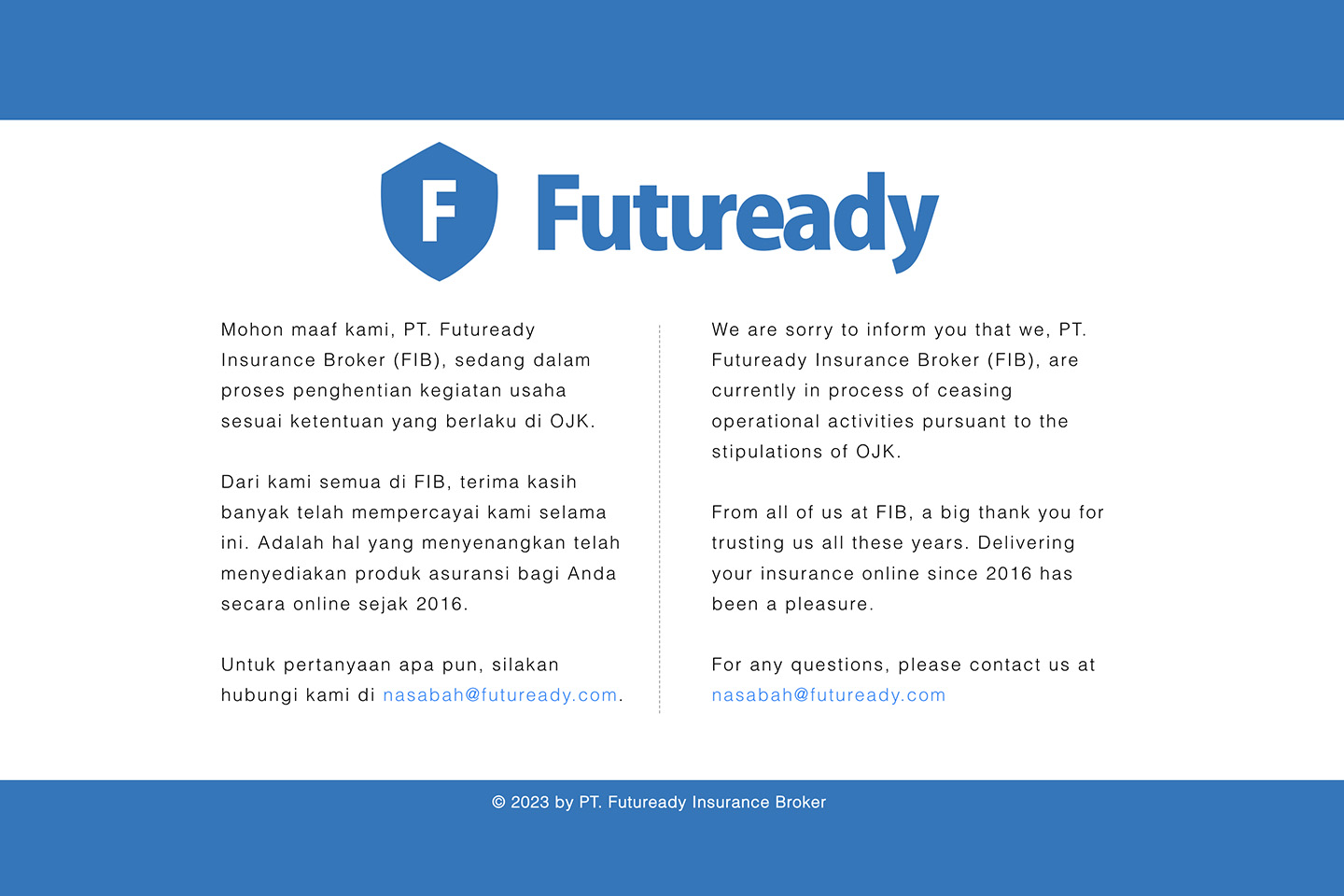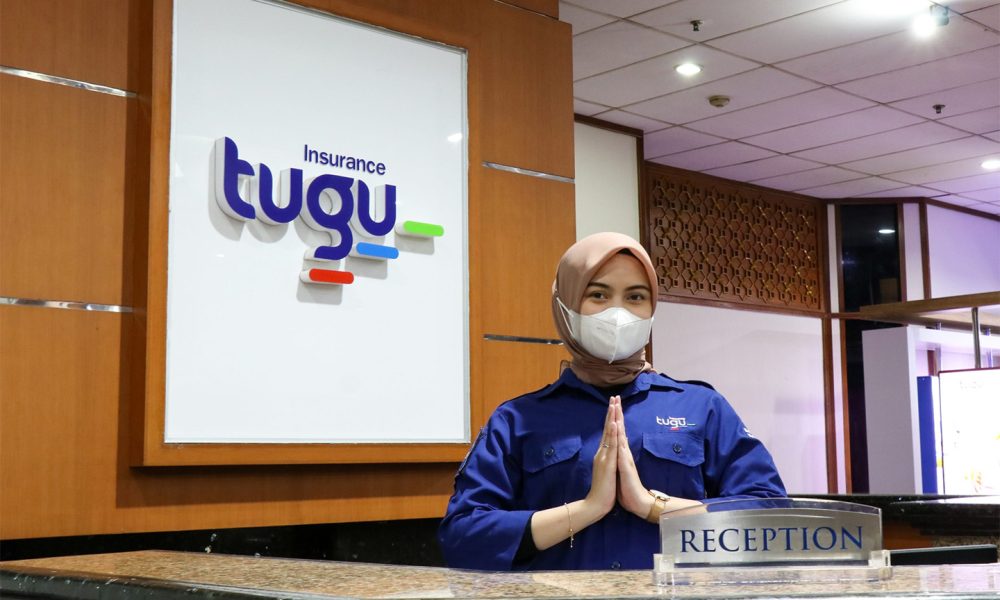Liga Asuransi – Hello, risk takers. How are you? I hope your business always goes as you expect. This time we will discuss the development of insurtech in Indonesia, which has been slow lately and needs to be taken more seriously so that insurance penetration to the public becomes wider.
Before we get into the topic of discussion, an insurtech startup in Indonesia raised the white flag in early July 2023. Futuready announces permanent closure in Indonesia. Through their official website, they announced that “We’re sorry, PT Futuready Insurance Broker (FIB) is no longer operating,” that’s what we quoted from the page. Then the company continued, “From all of us at FIB, thank you so much for trusting us all these years. It has been a pleasure to provide you with insurance products online since 2016.”
The page does not mention the reason for the decision taken.

Futuready is a brand carried by PT. Futuready Insurance Broker (FIB), established in 2015, and started operating in 2016, where most of its activities were carried out through online media, became one of the most well-known insurtechs.
Futuready focuses on four types of insurance product categories: travel insurance, health insurance, accident insurance, and car insurance.
Aegon Group owns Futready with 80% ownership, and 20% is owned by a local investor who doesn’t want to be named. Aegon Group is a life insurance company and asset manager based in The Hague, Netherlands.
Since it first started operating, Futuready has used its license as an insurance broker obtained from the OJK with number KEP-518/NB.1/2015
Insurance Product Marketing in the Digital Age
Penetration of insurance products into Indonesian society is relatively low, and many Indonesians still do not care about the importance of insurance in their daily lives. According to data from OJK, the penetration rate of insurance in Indonesia in 2021 will reach 3.18%, consisting of social insurance (1.45%), life insurance (1.19%), general insurance (0.47%), and the rest is mandatory insurance.
Meanwhile, the contribution of insurance industry assets to Indonesia’s GDP has only reached 5.8%, with a penetration rate below 4%. This figure is still much lower to be called a developed country, where the contribution of insurance to GDP is at least 20% of GDP.
According to PasarPolis Founder & CEO Cleosent Randing, the insurance industry has several fundamental problems. Among them are innovations that are not too fast, insurance products that cannot be reached by the wider community, and business processes in the insurance industry that are still manual. By looking at some of these problems, in fact, there are still many opportunities for digitizing insurance products that insurtech players can do.
Digital engagement of insurance products to the public is critical now. They are making insurance a new lifestyle for the Indonesian people by presenting products embedded insurance*. With embedded insurance, non-insurance companies can offer insurance products directly on their e-commerce platform. For example, several well-known marketplaces in Indonesia, such as Tokopedia, Shopee, and Blibli, always provide protection in the form of insurance for products purchased by their customers. Or as done by several official Apple outlets that work with Qoala to protect the form of insurance for mobile phones, laptops, watches, or tablets purchased at these outlets both online and offline.
Currently, it is necessary to take a direct approach to insurance for the community, so we as insurance must pick up the ball to the community by providing information and offerings directly to the community with the packaging of wiser risk management for the safety of the community itself and no longer waiting for the ball by waiting for people to come to the insurance and express their needs. It becomes complicated because most people do not realize or even understand the insurance product that is suitable for their needs, and in the end, there is a mistake in choosing an insurance product that they don’t really need, but instead, they don’t take what they really need. Education is what we need to do continuously by using social media.
This condition does not only occur in the community for insurance products for their personal lives. In the business class, the conditions are even more complex. With a much more diverse type of risk, of course, there will be fewer industrial people in general who understand what type of insurance is appropriate to protect their business. For this reason, the insurance company has to take education more seriously.
Developing application interfaces, artificial intelligence, and modular software enables third-party service providers for any sector seamlessly integrate innovative insurance solutions into their offerings and customer experiences. By enhancing value propositions and creating opportunities, embedded insurance can reach new or existing customers across digital touchpoints while simultaneously addressing many supply and demand issues and catalyzing the transformation of industry-wide business models.
Such conditions must be made suitable for the market personal insurance or business insurance so that all lines of society can be reached by insurance products more efficiently and more well-accepted.
The Role of Insurance Brokers in the Insurtech Era
Insurance brokers play a significant role in linking traditional insurance with the Insurtech trend despite the challenges faced. Here are some of their key roles:
- Information Provider: Insurance brokers continue to be essential sources of information for their clients. In the Insurtech era, they must be able to provide insight into the latest trends and innovations in the insurance industry.
- Professional Advisor: Although digital platforms provide a wealth of information, clients often need experienced and trusted advisors to help them understand insurance products that suit their needs.
- Solution Personalization: Based on their knowledge of the client and the market, insurance brokers can provide personalized insurance solutions according to each client’s unique needs.
- Efficient Claim Handling: Claims processes can be complex, and insurance brokers can assist their clients in overcoming claims challenges, including through the application of technology that facilitates the process.
Adaptation of Insurance Brokers with Technological Developments
Insurance brokers must adapt to technological developments to remain relevant in the Insurtech era. Some steps that can be taken are:
- Investment in Technology: Insurance brokers must invest in suitable technology to improve their operational efficiency and provide clients with a better experience.
- Partnerships with Insurtechs: Alliances with Insurtech companies can help insurance brokers enhance their technological capabilities and expand market reach.
- Improved Digital Literacy: Insurance brokers and their employees must increase digital literacy to understand better and utilize technology.
Insurance brokers are critical in creating synergies between traditional and technological approaches in the Insurtech era. Despite the challenges, insurance brokers can leverage technology to improve client service and stay relevant in a changing business environment. By combining their expertise as insurance advisors and leveraging the advantages of technology, insurance brokers can remain valuable partners for their clients in risk exposure and financial protection.
This article is brought to you by L&G Insurance Broker.
—
LOOKING FOR INSURANCE PRODUCTS? DON’T WASTE YOUR TIME AND CALL US NOW
24 JAM L&G HOTLINE: 0811-8507-773 (CALL – WHATSAPP – SMS)
website: lngrisk.co.id
Email: customer.support@lngrisk.co.id
—






























